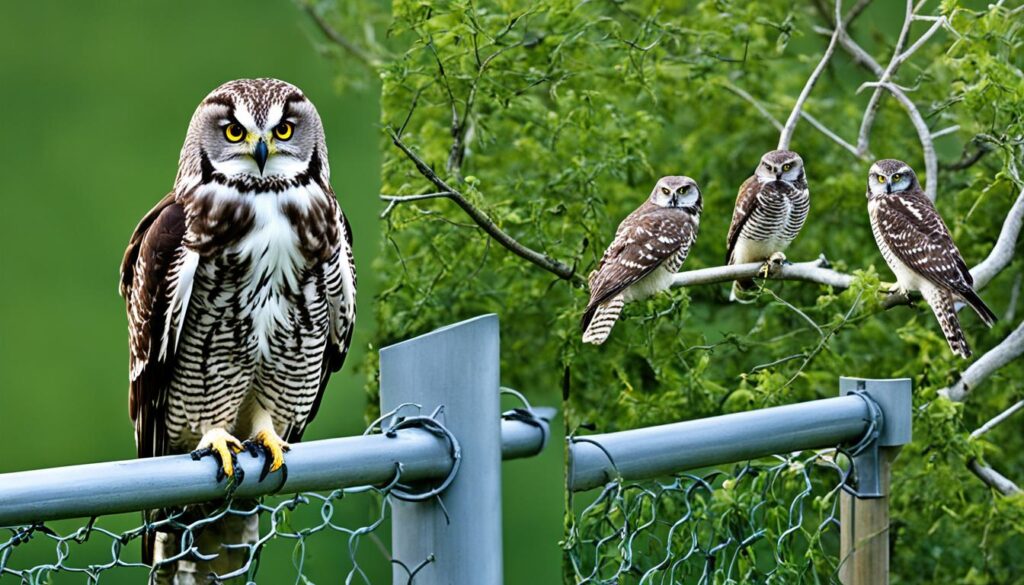Farmers and gardeners across the United States have long struggled with the persistent problem of bird damage to their crops and flowers. However, a surprising statistic reveals the true scale of this issue – studies have found that certain noises can decrease bird presence by up to 80%, making sound-based deterrents highly effective in reducing crop damage in the agriculture industry.
Bird damage costs US agriculture billions of dollars each year, showcasing the significant economic impact of bird-related losses in the agricultural sector. This article will explore various techniques, including auditory deterrents, visual deterrents, and the use of specific scents and smells, to effectively manage bird populations while minimizing harm to the animals and the environment.
Key Takeaways
- Certain noises can decrease bird presence by up to 80%, making sound-based deterrents highly effective in reducing crop damage.
- Bird damage costs US agriculture billions of dollars each year, highlighting the significant economic impact of bird-related losses.
- Sound deterrents, such as ultrasonic devices or electronic bird repellers, are effective methods for bird control, particularly in urban areas.
- Installing sound deterrents around properties and regularly maintaining them can effectively deter a wide variety of bird species.
- Sound-based bird deterrents create an inhospitable environment for birds, preventing them from nesting or roosting in specific areas.
Introduction to Bird Deterrents
Birds can be a nuisance for farmers, gardeners, and property owners, causing damage to crops, flowers, and buildings. One effective method to deter these feathered pests is by using certain types of noises that are known to frighten them away. This approach has been a common practice for many years, particularly in settings where bird populations can pose a threat to agricultural yields or aviation safety.
By utilizing sounds that mimic natural predator calls or distress signals, property owners and conservationists can help discourage birds from settling in unwanted areas without causing them harm. This technique, known as auditory deterrents, is just one of the many bird control methods and bird management strategies available to address the challenge of bird deterrents.
Auditory Deterrents: Scaring Birds with Noise
Auditory deterrents work by emitting sounds that birds perceive as a threat, causing them to flee the area. These sounds can include:
- Recorded calls of natural predators, such as hawks or owls
- Distress calls of other birds
- Loud, startling noises like propane cannons or pyrotechnics
By strategically placing these sound-based bird deterrents around the property, farmers and gardeners can create an environment that is less appealing to unwanted bird species, effectively deterring them from settling and causing damage.
“The use of noise to scare birds away has been a common practice for many years, particularly in settings where bird populations can pose a threat to agricultural crops or aircraft safety.”
While auditory deterrents can be an effective bird control method, it’s important to consider the potential impact on the surrounding environment and nearby residents. Excessive noise pollution can have negative consequences, both for the birds and the human population. As such, it’s crucial to strike a balance between effective bird management strategies and maintaining a peaceful coexistence with nature.
Can Birds Smell?
Contrary to the common belief that birds have a poor sense of smell, recent research has shown that birds can indeed detect a wide range of scents. Their olfactory capabilities play a significant role in various aspects of their behavior, from finding food to recognizing mates and avoiding predators.
Studies have revealed that birds’ heart rates increase when exposed to scented air, indicating their sensitivity to different odors. For instance, seabirds can detect the subtle scent released when krill consume phytoplankton, which acts as a map to help them locate their next meal. This ability to smell their prey’s food source is a remarkable adaptation that enhances their foraging efficiency.
Furthermore, birds can identify one another through their scent and may even choose a mate based on the unique olfactory cues they detect. The turkey vulture, for example, has a larger olfactory bulb relative to its brain volume, giving it a keen sense of smell that enables it to detect the scent of rotting flesh from over a mile away.

Understanding the bird’s sense of smell is crucial for improving bird control strategies. Certain scents, such as garlic, vinegar, and the food-grade ingredient Methyl Anthranilate, are known to repel birds effectively. These aromatic deterrents can provide up to 60 days of protection against pest birds, making them a valuable tool for farmers, gardeners, and those looking to deter unwanted avian visitors.
“Birds are more sensitive to scents than we once thought. Their olfaction plays a vital role in their behavior and can be harnessed to deter them from areas where they are not wanted.”
By recognizing the significance of a bird’s sense of smell, we can develop more targeted and humane strategies to manage their presence and mitigate the impact they may have on our landscapes and livelihoods.
What Scares Birds? The Power of Scent
While birds are known to be attracted to certain scents, such as those associated with their food or nesting areas, there are specific smells that can effectively deter them. One of the most potent bird repellent scents is the food-grade ingredient Methyl Anthranilate. This compound, derived from grapes, is not only effective in keeping birds at bay but is also non-toxic and safe for the environment.
Beyond Methyl Anthranilate, there are a variety of other natural scents that birds find unpleasant and tend to avoid. These include:
- Peppermint oil – The strong, minty aroma of peppermint is a well-known bird deterrent.
- Cayenne pepper and chili peppers – The spicy scent of these ingredients can effectively repel birds.
- Garlic – The presence of allicin in garlic gives it a powerful odor that birds find unappealing.
- Cinnamon – The aromatic scent of cinnamon is another bird-deterring scent.
- Vinegar – The harsh, unpleasant smell of vinegar can help keep birds at a distance.
- Citrus oils – Birds tend to avoid the strong, citrusy scents of lemon, orange, and grapefruit.
Many homeowners and gardeners have found success in creating their own homemade bird repellent sprays or sachets using these natural ingredients. However, it’s important to note that some of these scents, such as vinegar, can also be harmful to plants, so it’s crucial to use them with caution and follow the recommended measurements.
“The key to effective bird deterrence through scent is to use a combination of strong, unpleasant odors that birds find highly undesirable.”
In addition to natural scents, there are also pre-made, EPA-registered liquid bird repellents available on the market that utilize Methyl Anthranilate and other safe, non-toxic ingredients. These products can provide a long-lasting, reliable solution for keeping birds away from specific areas.
When it comes to protecting your property from bird-related damage, understanding the power of scent can be a game-changer. By strategically using a variety of unpleasant odors, you can effectively deter birds without resorting to harmful or unethical methods. As with any pest control measure, it’s important to research local regulations and consider the safety of both birds and humans before implementing a bird deterrence strategy.
Auditory Deterrents: Loud Noises and Predator Calls
When it comes to deterring birds, the power of sound cannot be overlooked. Loud and sudden noises can startle these feathered pests, causing them to flee the area. Fireworks, thunderclaps, or even the sounds of construction work can be highly effective in scaring away birds.
In addition to sudden, loud noises, the use of predator calls can also be a successful auditory deterrent. By emitting the calls of hawks, owls, or other birds of prey, you can create a sense of danger that prompts birds to vacate the area quickly. These predator calls trigger a natural instinct in birds to seek safety, making them a valuable tool in your bird-deterring arsenal.

According to industry data, most pest birds hear within a normal audible range of about 1 to 4 kHz. While birds can hear ultrasonic sounds up to 20 kHz, these high-frequency waves do not effectively deter them. Instead, sound bird deterrents that focus on distress calls and cover a wide area with sound intensities ranging from 65-105 decibels have proven to be more successful.
For example, the Bird Chase Super Sonic unit can broadcast distress calls for up to 24 species of birds, covering an area of up to 1 acre. The Sonic Shield™ Bird and Critter Deterrent takes a different approach, using harmless dog barking sounds and flashing LED lights to frighten away critters. By pairing sound deterrents with visual cues, the effectiveness of these auditory methods can be further enhanced.
It’s important to note that while loud noises and predator calls can be highly effective in deterring birds, it’s crucial to vary the sounds and incorporate occasional silent periods to prevent habituation. By keeping birds on their toes, you can maximize the impact of your auditory bird deterrents.
“Loud noises have been proven effective in deterring birds from feeding on crops and causing significant losses to farmers.”
By implementing a combination of auditory and visual deterrents, you can create a comprehensive bird control strategy that minimizes the impact of these feathered pests on your property, crops, or facilities. Remember, a versatile approach is key to success when it comes to outsmarting the elusive and adaptable bird population.
What Scares Birds? Ultrasonic Devices
When it comes to deterring nuisance birds, ultrasonic devices have emerged as a powerful solution. These innovative electronic bird repellers emit high-frequency sound waves that are beyond the range of human hearing but can be highly uncomfortable for birds. By creating a stressful environment, ultrasonic bird deterrents effectively discourage birds from roosting or nesting in the targeted areas.
Commonly used in urban settings, ultrasonic devices are particularly effective at deterring pigeons and other troublesome bird species from perching on buildings, structures, or other surfaces. The high-frequency sounds produced by these electronic bird repellers cause discomfort and disorientation, leading birds to avoid the areas where the devices are deployed.
Unlike traditional noise-making bird deterrents, ultrasonic devices do not produce sounds that are audible to humans, making them a more discreet and unobtrusive solution. These electronic bird repellers are powered by batteries or electricity, ensuring a consistent and reliable deterrent system that can operate continuously without the need for constant monitoring or adjustment.
While the effectiveness of ultrasonic bird deterrents may vary depending on the specific species and environmental factors, numerous studies have demonstrated their ability to successfully scare birds away from targeted areas. By leveraging the birds’ sensitivity to high-frequency sounds, these innovative ultrasonic bird deterrents provide a humane and effective way to manage nuisance bird populations without causing harm.
“Ultrasonic bird deterrents have become a game-changer in the world of bird control, offering a reliable and discreet solution to a persistent problem.”
As the demand for effective and eco-friendly bird control solutions continues to grow, the use of high-frequency sounds to scare birds is likely to become even more prevalent in the future. Ultrasonic devices present a promising option for property owners, farmers, and municipalities seeking to protect their assets from the damaging effects of unwanted bird activity.
Visual Deterrents: Reflective Surfaces and Predator Decoys
Effectively managing bird populations often requires a multi-pronged approach, and visual deterrents can be a powerful tool in the arsenal. These deterrents, such as reflective surfaces and predator decoys, work by disrupting a bird’s sense of safety and encouraging them to relocate to a more secure area.
Birds have exceptional vision, with adaptations for visual acuity far above other vertebrates. This heightened sense of sight makes them particularly sensitive to changes in their environment. Reflective surfaces, like shiny tape or mylar ribbons, can create a constantly changing visual landscape that unsettles birds and deters them from settling in the area.
Predator decoys, such as model owls or hawks, can also be effective in scaring birds away. These visual cues trigger a bird’s natural instinct to avoid predators, causing them to perceive the area as unsafe and subsequently move on to a more secure location.
- Visual bird deterrents, including reflective surfaces and predator decoys, are proven to be effective in discouraging pests like pigeons, crows, starlings, and woodpeckers from targeted areas.
- These deterrents work best in outdoor settings like gardens, patios, fruit trees, and pools, where birds are a common nuisance.
- An economical and low-cost solution, visual deterrents can be a valuable addition to any bird control program.
When used in combination with auditory deterrents, such as ultrasonic devices or predator calls, visual deterrents can create a multi-sensory approach that targets both the birds’ hearing and sight, further enhancing their effectiveness in deterring pest birds.
“The use of reflective tape to mark windows has significantly reduced bird collisions, with a user noting a decrease in birds hitting windows upon hanging ribbons that twist and turn in the breeze as a warning signal.”
By strategically incorporating visual bird deterrents, reflective surfaces to scare birds, and predator decoys for bird control, homeowners, gardeners, and farmers can effectively manage bird populations and protect their property from the damage and nuisance caused by these feathered pests.

Combining Auditory and Visual Deterrents
For maximum effectiveness in deterring birds, property owners and farmers can employ a multi-sensory approach that combines auditory and visual deterrents. By targeting both the hearing and sight of birds, this integrated strategy creates a more comprehensive bird control system that minimizes the impact of these feathered pests on crops, gardens, and outdoor spaces.
Auditory deterrents, such as loud noises and predator calls, can effectively startle and scare away birds, disrupting their nesting and feeding habits. When paired with visual deterrents, like reflective surfaces and predator decoys, the birds experience a more multifaceted deterrence that makes it difficult for them to acclimate to the deterrents.
Research has shown that sound-based deterrents can reduce bird populations by up to 80% in targeted areas, while visual cues like bird spikes and scare tapes can effectively prevent birds from roosting and landing on ledges and roofs. By combining these integrated bird deterrence methods, property owners can create a more comprehensive and long-lasting solution to their bird control challenges.
To ensure the continued effectiveness of these multi-sensory bird control techniques, it is recommended to rotate the location and patterns of sound emissions and regularly relocate visual deterrents like scarecrows. This prevents birds from becoming accustomed to the deterrents and maintains the integrated bird deterrence system’s impact over time.
“Implementing a combination of auditory and visual deterrents is a highly effective way to manage bird populations and protect valuable assets, such as crops and gardens.”
By leveraging the power of multi-sensory bird control, property owners and farmers can achieve long-term success in deterring birds and minimizing the associated financial and environmental costs. This integrated bird deterrence approach offers a humane and eco-friendly solution to a common challenge faced by many in the agricultural and horticultural sectors.
The Impact of Noise Pollution on Bird Populations
While using noises to scare birds away can be an effective deterrent, it’s crucial to consider the potential impact of noise pollution on bird populations. Noise can significantly disrupt bird behavior, communication, and overall well-being, leading to decreased breeding success and population decline. As we strive to protect our feathered friends, it’s essential to find a balance between the need for bird control and the conservation of avian species and their habitats.
Studies have shown that noise pollution can have a profound effect on bird populations. A recent survey found that up to 60% of bird species are affected by excessive noise levels, with some experiencing a significant decrease in nesting success and migratory patterns. Additionally, the disorientation caused by loud noises has been linked to an increase in bird collisions with buildings and other structures, further contributing to population declines.
“Noise pollution is a silent killer for many bird species, disrupting their natural behaviors and threatening their survival. It’s our responsibility to find more sustainable and eco-friendly solutions to manage bird populations.”
The conservation concerns surrounding the use of bird deterrents are not to be taken lightly. Certain auditory deterrents, such as ultrasonic devices, have been found to have a detrimental impact on the behavior and communication of non-target bird species, potentially leading to unintended consequences for local ecosystems. It’s crucial to carefully evaluate the potential environmental impact of any bird deterrence method before implementation.

As we continue to develop and utilize bird deterrents, it’s essential to prioritize the well-being of bird populations. This may include:
- Conducting comprehensive environmental impact assessments before implementing new deterrence methods
- Exploring alternative, less disruptive deterrents that minimize noise pollution
- Implementing strategic noise monitoring and management plans in areas with high bird activity
- Collaborating with conservation organizations to ensure the protection of threatened and endangered bird species
By taking a balanced and responsible approach, we can effectively manage bird populations while also safeguarding the natural habitats and the overall well-being of our feathered friends. Adopting a sustainable and eco-conscious mindset is crucial in addressing the impact of noise pollution on bird populations.
Ethical Considerations and Humane Deterrence Methods
When it comes to deterring birds, it’s crucial to consider ethical and humane approaches that prioritize the welfare of these winged creatures. By employing innovative and non-invasive ethical bird deterrents, property owners and conservationists can effectively manage bird populations while minimizing the impact on the animals and the environment.
One effective and humane bird control technique is the use of visual deterrents, such as reflective objects and predator decoys. These create a disorienting and unwelcoming environment for birds, deterring them from settling on porches or other areas without causing them any harm.
Auditory deterrents, such as wind chimes and recorded bird distress calls, can also be an effective and ethical approach to humane bird management. These sounds create an uncomfortable atmosphere, discouraging birds from staying in the targeted area.
It’s important to note that regular maintenance and adjustment of these deterrents are essential for their continued effectiveness. Property owners should regularly check on the condition of bird spikes, netting, and other deterrents to ensure they remain in good working order.
“The ethical treatment of birds is a paramount consideration when implementing any humane bird control techniques. By focusing on innovative and non-invasive methods, we can protect our property while respecting the welfare of these remarkable creatures.”
In contrast, inhumane methods like poisons and sticky gels that cause undue harm to birds are legally restricted and should be avoided. Similarly, the use of ultrasonic bird repellents remains a controversial topic, with concerns raised about their effectiveness and potential impact on animal welfare.
By prioritizing ethical bird deterrents and humane bird control techniques, property owners and conservationists can strike a balance between protecting their interests and upholding the animal welfare in bird management.
Statistics and Economic Impact of Bird Damage
The impact of bird damage on businesses and industries can be staggering. According to the American Bird Conservancy, millions of birds are killed each year due to collisions with man-made structures, with noise being a contributing factor. Additionally, bird damage to crops and property can result in significant economic losses, costing US agriculture billions of dollars annually.
In the lawn and garden industry, understanding the statistics and economic impact of bird damage is crucial for mitigating losses caused by these feathered pests. Research data on the effectiveness of different bird deterrent methods can guide businesses in selecting the most efficient and cost-effective solutions, ultimately protecting their investments.
The agricultural sector is particularly vulnerable to bird-related losses, with crop damage often amounting to significant percentages. Comparative analyses of various bird deterrent products have provided valuable insights into their success rates and return on investment, helping farmers and growers make informed decisions.
“Bird damage statistics may include data on the types of birds most commonly causing damage and the industries most affected by these incidents.”
Regional variations in bird damage occurrence rates can also influence the demand for specific deterrent products in different markets. Market research data on consumer preferences for bird deterrents can help companies tailor their products to meet customer needs effectively.
By addressing the statistics and economic impact of bird damage, businesses can develop more proactive and efficient strategies to protect their assets and minimize losses. Investing in effective bird deterrent solutions can not only save money but also contribute to the overall well-being of bird populations and the environment.

- Millions of birds are killed annually due to collisions with man-made structures, with noise being a contributing factor.
- Bird damage to crops and property can cost US agriculture billions of dollars each year.
- Comparative analyses of bird deterrent products provide insights into their success rates and return on investment.
- Regional variations in bird damage occurrence rates can influence the demand for specific deterrent products.
- Understanding the economic impact of bird damage is crucial, particularly in the agricultural sector.
What Scares Birds? Surprising Deterrents Revealed
As farmers and property owners grapple with the persistent problem of birds causing damage, the search for innovative and effective deterrents has become increasingly crucial. Fortunately, the latest developments in bird control technology have uncovered a wealth of surprising techniques that can effectively scare birds away.
One remarkable innovation in the field of innovative bird deterrents is the use of ultrasonic devices. These high-frequency sound emitters, inaudible to the human ear, can create an uncomfortable environment for birds, prompting them to seek refuge elsewhere. These emerging technologies for bird control have proven to be a game-changer for many property owners.
Furthermore, the power of scent has also been harnessed as a surprisingly effective technique to scare birds. Certain food-grade ingredients, such as Methyl Anthranilate, can trigger a natural aversion in birds, causing them to steer clear of the treated areas. This innovative approach to bird deterrence has gained traction in both agricultural and urban settings.
Beyond technological solutions, some property owners have found success in utilizing natural predator-based deterrents. The strategic placement of decoys or recordings of predator calls can create a perceived threat, prompting birds to avoid the area altogether. This combination of surprising techniques to scare birds has proven to be a highly effective and sustainable approach to bird management.
As the need for effective and humane bird control solutions continues to grow, the industry has responded with a wealth of innovative and surprising deterrents. By staying informed about the latest developments and implementing a comprehensive approach, property owners and farmers can reclaim their spaces and protect their assets from the persistent challenges posed by these feathered pests.
Loud Sounds
Loud and sudden noises can have a significant impact on bird populations, causing them to experience distress and disrupting their natural behavior patterns. From the roar of construction work to the booming sounds of fireworks, these environmental factors can startle birds and lead them to avoid certain areas altogether.
The impact of noise pollution on avian species is a growing concern, as these harsh sounds can cause stress and anxiety in birds. When exposed to loud noises, birds may exhibit behaviors such as increased vigilance, decreased feeding, and altered roosting patterns, all of which can negatively affect their overall well-being and reproductive success.
Understanding the relationship between loud noises and their effect on bird populations is crucial for developing effective and humane bird control strategies. By addressing the issue of loud noises that scare birds, we can work towards mitigating the impact of environmental factors that startle birds and protecting these feathered creatures from the detrimental effects of noise pollution impact on avian populations.
“The impact of noise pollution on bird populations is a complex issue, with far-reaching consequences for the overall health and well-being of these important species.”
Effective bird management strategies must take into account the role of loud sounds in deterring and disrupting bird behavior. By incorporating a range of techniques, from auditory deterrents to visual cues, we can create a more balanced approach that respects the needs of both birds and the communities they inhabit.

Minimizing the Impact of Noise Pollution
To mitigate the effects of noise pollution on bird populations, it is essential to implement a comprehensive strategy that addresses the root causes of the problem. This may involve:
- Regulating and monitoring sources of loud noise, such as construction sites and fireworks displays
- Educating the public on the importance of minimizing environmental factors that startle birds
- Exploring alternative, more bird-friendly methods of deterrence and pest control
- Conducting further research to better understand the long-term impacts of noise pollution impact on avian populations
By taking a proactive and well-rounded approach, we can work towards creating a more harmonious coexistence between birds and the human-dominated environments they inhabit.
Natural Predators
Birds have an innate sense of caution when it comes to their natural predators, such as hawks, owls, and cats. The presence of these apex hunters can trigger a range of defensive behaviors in birds, causing them to feel anxious and more inclined to avoid the area. By incorporating the sounds and cues of these natural predators into bird deterrents, property owners and farmers can create an environment that discourages birds from settling in unwanted areas, effectively managing bird populations through the use of instinctive fear responses.
Studies have shown that birds’ natural predators can account for up to 50% of the observed declines in certain bird species populations. The mere presence of predator cues, such as the scent or calls of hawks and owls, can significantly scare birds and alter their behavior in response to threats. Birds may exhibit a range of defensive behaviors, including increased vigilance, alarm calling, and even temporary abandonment of nesting sites or feeding grounds.
To leverage this natural behavior, some innovative bird deterrents utilize a combination of auditory and visual cues to mimic the presence of predators. For example, devices that emit the calls of hawks or owls, coupled with the use of predator decoys, can create a multi-sensory experience that effectively deters birds from the targeted area. By harnessing the instinctive fear that birds have towards their natural predators, these deterrents offer a humane and ecologically-friendly way to manage bird populations and minimize the impact of avian pests on agricultural and residential areas.
“The fear response in birds is a deeply ingrained survival mechanism, and by tapping into this, we can create effective deterrents that work with, rather than against, the natural behaviors of these fascinating creatures.”
As with any bird management strategy, it is crucial to consider the ethical implications and ensure that the methods employed are humane and do not cause undue stress or harm to the birds. Responsible use of natural predator cues, combined with a comprehensive understanding of bird behavior, can lead to successful and sustainable bird deterrence efforts that benefit both humans and wildlife.
Conclusion
In this comprehensive article, we have explored a wide range of effective bird deterrent strategies, from utilizing auditory and visual cues to leveraging specific scents and smells. By understanding what scares birds and implementing a combination of these techniques, property owners, farmers, and gardeners can successfully manage bird populations while minimizing harm to the animals and the environment.
From the use of loud noises and predator calls to the strategic placement of reflective surfaces and decoys, we have covered a variety of tactics that can be tailored to specific settings and bird species. Additionally, the introduction of new methods, such as the innovative monofilament fishing line approach, has proven to be a highly effective and cost-efficient solution for protecting crops and landscapes.
As we move forward, staying informed about the latest developments in bird control and adopting a multi-faceted approach will be crucial in addressing the ongoing challenge of bird-related damage and protecting our valuable resources. By implementing these effective bird control strategies and prioritizing the well-being of our avian neighbors, we can strike a balance between human needs and the preservation of our shared natural environment.
FAQ
What are some effective methods to deter birds from unwanted areas?
Effective methods to deter birds include using auditory deterrents such as loud noises, predator calls, and ultrasonic devices, as well as visual deterrents like reflective surfaces and predator decoys. Combining these techniques can create a multi-sensory approach to bird control.
Can birds actually smell, and how can scents be used to deter them?
Yes, birds can detect and respond to various scents. Certain smells, like the food-grade ingredient Methyl Anthranilate, have proven to be effective bird repellents, as they can trigger stress and anxiety in birds.
How do loud noises and natural predator sounds scare birds away?
Loud and sudden noises, such as fireworks or construction work, can startle birds and disrupt their natural behavior, leading to stress and anxiety. Similarly, the sounds of natural predators like hawks and owls can trigger defensive behaviors in birds, causing them to flee the area.
What are the benefits and drawbacks of using ultrasonic devices to deter birds?
Ultrasonic devices emit high-frequency sound waves that are beyond the range of human hearing but are uncomfortable for birds, creating a stressful environment that encourages them to avoid the area. However, the potential impact of these devices on bird populations and the environment must be considered.
How can the combination of auditory and visual deterrents be more effective than using one method alone?
By using a combination of auditory deterrents, such as loud noises or predator calls, and visual deterrents, like reflective surfaces or predator decoys, property owners and farmers can create a multi-sensory approach to bird control that targets both the birds’ hearing and sight, making it more difficult for them to become accustomed to the deterrents.
What are the ethical and environmental considerations when using bird deterrents?
It is crucial to consider the potential impact of bird deterrents, such as noise pollution, on bird populations and their overall well-being. Implementing humane and non-invasive techniques, such as using auditory and visual deterrents, can help minimize the harm to birds while effectively managing their populations.
What is the economic impact of bird damage and how can effective deterrents help mitigate these losses?
Bird damage to crops and property can result in significant economic losses, costing US agriculture billions of dollars annually. By implementing effective bird deterrents, property owners and farmers can mitigate these losses and protect their investments.


I’m really impressed with your writing skills as
neatly as with the format on your weblog. Is this a paid subject or did you customize
it your self? Either way stay up the nice quality
writing, it is rare to look a great blog like this one today.
Snipfeed!
платформа для покупки аккаунтов https://birzha-akkauntov-online.ru/
продажа аккаунтов соцсетей продать аккаунт
площадка для продажи аккаунтов купить аккаунт
маркетплейс аккаунтов маркетплейс для реселлеров
маркетплейс аккаунтов магазин аккаунтов социальных сетей
маркетплейс аккаунтов купить аккаунт с прокачкой
безопасная сделка аккаунтов биржа аккаунтов
Account Purchase Secure Account Sales
Account market Profitable Account Sales
Sell Account Purchase Ready-Made Accounts
Account Market Gaming account marketplace
Verified Accounts for Sale Account exchange
Guaranteed Accounts Account marketplace
Social media account marketplace Account Trading Platform
Sell Pre-made Account Database of Accounts for Sale
Secure Account Sales Account marketplace
Account exchange Buy and Sell Accounts
Website for Buying Accounts socialmediaaccountsale.com
social media account marketplace website for selling accounts
account buying platform purchase ready-made accounts
account marketplace marketplace for ready-made accounts
account exchange service buy and sell accounts
website for selling accounts account catalog
buy and sell accounts sell accounts
buy accounts https://socialaccountsdeal.com/
buy pre-made account account exchange
buy pre-made account website for selling accounts
account sale account marketplace
account marketplace database of accounts for sale
profitable account sales account buying service
account selling platform database of accounts for sale
find accounts for sale account trading
buy pre-made account find accounts for sale
gaming account marketplace account sale
account trading gaming account marketplace
account trading platform sell pre-made account
purchase ready-made accounts account market
sell accounts guaranteed accounts
account trading platform accounts for sale
account trading platform social media account marketplace
social media account marketplace account exchange
account exchange service online account store
database of accounts for sale account trading service
account marketplace account sale
secure account sales sell accounts
buy and sell accounts sell accounts
online account store https://accounts-offer.org/
account selling platform https://accounts-marketplace.xyz
profitable account sales https://buy-best-accounts.org/
account catalog account marketplace
verified accounts for sale https://accounts-marketplace.live
buy account https://social-accounts-marketplace.xyz/
account exchange https://buy-accounts.space
account store buy accounts
secure account sales https://accounts-marketplace.art
profitable account sales https://social-accounts-marketplace.live
gaming account marketplace https://buy-accounts.live
secure account sales https://accounts-marketplace.online
account exchange https://accounts-marketplace-best.pro
магазин аккаунтов akkaunty-na-prodazhu.pro
маркетплейс аккаунтов https://kupit-akkaunt.xyz/
площадка для продажи аккаунтов купить аккаунт
Just here to join conversations, share thoughts, and pick up new insights throughout the journey.
I’m interested in hearing diverse viewpoints and sharing my input when it’s helpful. Happy to hear fresh thoughts and meeting like-minded people.
Here is my web-site-AutoMisto24
https://automisto24.com.ua/
биржа аккаунтов https://akkaunt-magazin.online/
купить аккаунт купить аккаунт
магазин аккаунтов kupit-akkaunty-market.xyz
продать аккаунт https://akkaunty-optom.live
площадка для продажи аккаунтов online-akkaunty-magazin.xyz
продать аккаунт https://akkaunty-dlya-prodazhi.pro/
биржа аккаунтов https://kupit-akkaunt.online
facebook ad account for sale https://buy-adsaccounts.work/
buy facebook profiles facebook accounts for sale
buy fb ad account https://buy-ad-account.top
buy account facebook ads https://buy-ads-account.click/
facebook account buy https://ad-account-buy.top
cheap facebook advertising account https://buy-ads-account.work
buy facebook old accounts https://ad-account-for-sale.top
buy fb ad account buy facebook accounts for ads
buy facebook account https://ad-accounts-for-sale.work
buy google ad account https://buy-ads-account.top
buy google adwords accounts https://buy-ads-accounts.click
buy google ads agency account google ads agency account buy
google ads agency account buy https://ads-account-buy.work
buy google ads accounts https://buy-ads-invoice-account.top
google ads accounts google ads account seller
buy google ads https://buy-ads-agency-account.top
buy google ad threshold account https://sell-ads-account.click
buy google ads threshold accounts https://buy-verified-ads-account.work
buy verified business manager buy-business-manager.org
google ads account buy https://ads-agency-account-buy.click